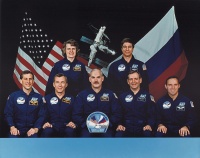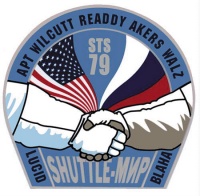STS-79
From The Space Library
 | |
| Organization | NASA-Office of Space Flight (United States) |
|---|---|
| Mission type | Human Crew |
| Launch date | September 16, 1996 |
| Launch vehicle | Space Shuttle |
| Launch site | Cape Canaveral, United States |
| COSPAR ID | 1996-057A |
| Inclination | 51.6 degrees |
| Experiments | Here |
| Alternate Names | 24324 |
| Additional Information | Here |
| Data Collection | Here |
| Payload Mass Up | 8852.3 kg |
| Payload Mass Down | 8339.09 kg |
| Orbiter | Atlantis |
| Lift Off Mass | 2,050,161.82 kg |
| Orbiter Weight at Liftoff | 113,330.45 kg |
| Orbiter Weight at Landing | 97,807.27 kg |
| Landed | Concrete runway 15 at Kennedy Space Center, Fla. |
| Orbits of Earth | 160 |
| Orbital Altitude | 213 nautical miles (245 statute miles) |
Contents |
[edit] Crew
- Commander: William F. Readdy
- Pilot: Terrence W. Wilcutt
- Payload Commander:
- Mission Specialist 1: Thomas D. Akers
- Mission Specialist 2: Jerome Apt
- Mission Specialist 3: Carl E. Walz
- Mission Specialist 4:
- Mission Specialist 5:
- Payload Specialist 1:
- Payload Specialist 2:
ISS/Mir Crew Transport
- John E. Blaha - up only, Shannon W. Lucid - down only
[edit] Mission
STS 79 was the 79th Shuttle mission, the 4th Shuttle-Mir docking, the 1st US crew exchange, and the 32nd KSC landing. The mission was highlighted by the return to Earth of US astronaut Shannon Lucid after 188 days in space which set a new US record for long-duration as well as a world record for a woman. Succeeding her on Mir for an approximately four-month stay was Mission Specialist John E. Blaha who returned with the STS 81 crew. STS 79 marked the second flight of the SPACEHAB module in support of the Shuttle-Mir activities and first flight of the SPACEHAB Double Module configuration. During 5 days of mated operations, two crews transferred more than 4,000 pounds (1,814 kg) of supplies to Mir, including logistics, food and water generated by orbiter fuel cells. Three experiments also were transferred: Biotechnology System (BTS) for study of cartilage development; Material in Devices as Superconductors (MIDAS) to measure electrical properties of high- temperature superconductor materials; and Commercial Generic Bioprocessing Apparatus (CGBA), containing several smaller experiments, including self- contained aquatic systems. About 2,000 pounds (907 kg) of experiment samples and equipment were transferred from Mir to Atlantis. During her approximately six-month stay on Mir, Lucid conducted research in the following fields: advanced technology, Earth sciences, fundamental biology, human life sciences, microgravity research and space sciences. Specific experiments included: Environmental Radiation Measurements to ascertain ionizing radiation levels aboard Mir; Greenhouse- Integrated Plant Experiments, to study the effects of microgravity on plants, specifically dwarf wheat; and Assessment of Humoral Immune Function During Long-Duration Space flight, to gather data on the effect of long-term spaceflight on the human immune system and involving the collection of blood serum and saliva samples. Some research was conducted in the newest and final Mir module, Priroda, which arrived at the space station during Lucid's stay. Three experiments remained on Atlantis: Extreme Temperature Translation Furnace (ETTF), a new furnace design allowing space-based processing up to 871 degrees F (1,600 degrees C) and above; Commercial Protein Crystal Growth (CPCG) complement of 128 individual samples involving 12 different proteins; and Mechanics of Granular Materials, designed to further understanding of behavior of cohesionless granular materials, which could in turn lead to better understanding of how the Earth's surface responds during earthquakes and landslides. STS 79's crew consisted of the following: Commander : Willaim F. Readdy (3rd Shuttle flight) Pilot : Terrence W. Wilcutt (2) Mission Specialist : Tom Akers (4) Mission Specialist : Jay Apt (4) Mission Specialist : Carl E. Walz (3) Mission Specialist : John E. Blaha (5)
[edit] EVA
[edit] Payload
Shuttle-Mir Mission 04; SPACEHAB/Mir 05; orbiter docking system; Shuttle-Mir Mission 04 middeck science; Shuttle Amateur Radio Experiment (SAREX) II, configuration M; IMAX in-cabin camera; Midcourse Space Experiment (MSX)
[edit] Books about the Space Shuttle Program
Buy This Book Click here |
Buy This Book here |
Buy This Book Click here |
Buy This Book Click here |





